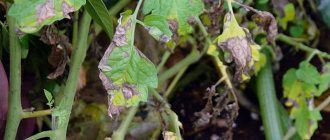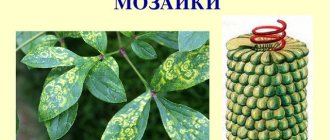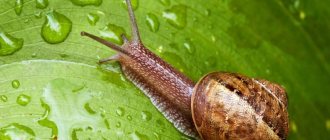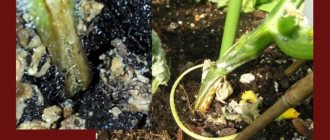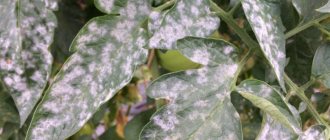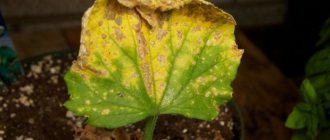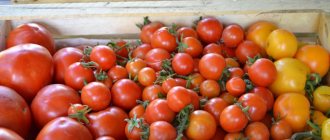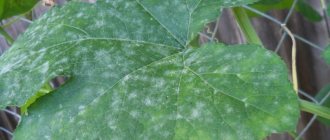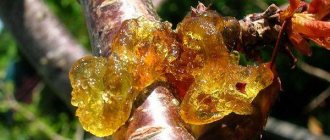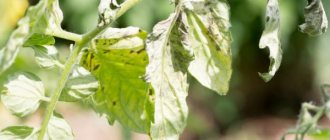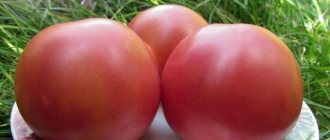As sad as it is to admit, despite such care, rotten fruits right on the branches of a fruit tree are a fairly common occurrence in our gardens, as well as scab.
In order to prevent apple trees from having fruit rot (moniliosis), it is necessary to carry out preventive measures annually and regularly: start in early spring, when the snow has just melted , and end in the fall, after harvesting .
There are also relatively effective ways to combat moniliosis (fruit rot) in the active stage of the disease. We'll talk about all this in this article.
Why do fruits on apple tree branches rot?
Fruit rot is considered a consequence of preliminary damage to the surface of the apple peel. These could be various pests (insects), hail, or simply the predisposition of a given fruit tree variety to disease. Most often these are fruits with thin skin.
A huge number of gardeners face this problem. Getting rid of it is not so easy. And if you talk in order to forget forever, then it’s completely unrealistic. There is currently no biological method for destroying fruit rot . And no developments are being carried out in this direction. It's all about the endurance of the spores, which are quite difficult to destroy.
Fruit rot or moniliosis
The disease is particularly active in hot and humid summers. And that’s exactly what the seasons have been like in recent years.
The use of reusable spraying with fungicides greatly facilitates the entire process of combating moniliosis. But we cannot talk about a complete solution to the problem. The main reason for this situation is considered to be the impossibility of simultaneous treatment of all nearby trees and plants with medicinal preparations . Plus, the development of spores can even occur in microcracks in the fruit or tree bark. And they can be damaged by various other types of pests. “Bad helpers” in this matter can be wasps, scab, powdery mildew and leaf rollers, which can create characteristic damage for activating moniliosis. And after a couple of days, the tree is already affected. All that remains is to wait for active signs and symptoms of fruit rot disease.
If you do not pick every single infected fruit and burn them, the situation will repeat itself next year . But the number of infected apples will be much greater. In late autumn, rotten fruits and infected leaves should also be destroyed.
After carrying out preventive work to combat fruit rot and spraying trees with special compounds, you can rest assured about your future harvest.
It is impossible to get rid of fruit rot in one season. Therefore, it is recommended to repeat measures to combat moniliosis every season until you are sure that the disease has receded.
Characteristic signs of a fungal disease
The main symptom indicating that an apple tree is infected with a fungus is the presence of brown spots on the fruit, rapidly spreading over their entire surface. Other signs are expressed as follows:
- cessation of fruit growth, presence of numerous damage by worms;
- loss of elasticity in the pulp;
- the appearance of small brown spots that increase in size over time;
- the appearance of gray conidia on the surface of rotting apples.
Penetration of infection into the pulp of fruits occurs through damage caused by harmful insects, birds and wasps.
Rotting apples can be caused by one of the following diseases:
- moniliosis;
- chlorosis;
- flycatcher;
- scab.
Moniliosis
Monilial blight and fruit rot is a fungal disease caused by the ascomycete Monilia.
The disease is especially common in regions with temperate climates and long, cold springs. Trees usually become infected at the flowering stage. After the infection penetrates through the tree bark, an incubation period begins, lasting up to 14 days; at the end of it, the flowers and leaves turn brown, dry out and die. In warm and damp weather, fungal spores appear in the form of a white coating on the stalks and the inside of the leaves. Subsequently, the mycelium spreads throughout the garden area, carried by the wind or pests. In diseased trees, brown spots form on the fruits, gradually affecting the entire surface.
As a result, the apple pulp becomes loose, turns brown and acquires a wine-alcohol flavor. After 10 days from the moment of infection, miniature creamy pads - sporodochium - appear on the surface of the fruit. Apples affected by the fungus most often become mummified and remain on the tree until the end of winter.
Ideal conditions for the development of fruit rot are high humidity (up to 90%) and moderate temperature (from +15 to +20 °C).
Chlorosis
This disease is characterized by a failure in the formation of chlorophyll in the leaves and a decrease in photosynthetic activity.
Chlorosis is usually caused by infection of the tree with viruses or fungal microorganisms. Pathogens are carried by wind or harmful insects. Non-infectious chlorosis develops as a result of violation of the rules of agricultural technology, as well as in unfavorable soil and climatic conditions. Main symptoms of the disease:
- premature yellowing of young leaf blades, while their veins do not change color, remaining green;
- slow growth of leaves, as a result of which their size becomes smaller than usual;
- curling of leaves at the edges;
- drying and falling of flowers and leaf blades;
- deformation of buds;
- gradual death of the root system;
- decreased fruiting, damage and rotting of fruits.
Non-infectious chlorosis is easily treated by replenishing one or another microelement missing from the tree.
Scab
Scab is a disease caused by the fungal microorganism Venturia inaequalis.
The infection affects the leaf blades and fruits of apple trees, which significantly reduces the volume and quality of the harvest. The pathogen in the pseudothecia stage overwinters in fruits and fallen leaves. The dispersal of fungal spores occurs with the beginning of the development of young shoots. Basically, apple trees become infected with scab during the period of swelling of the buds, formation and coloring of buds, flowering and shedding of petals. Fungal spores settle on the inside of leaf blades, and when the humidity level increases, they begin to germinate into their skin. After 2–3 weeks, the conidial stage begins, when microorganisms transformed into conidia secondarily infect the leaves of the crown. The favorable air temperature for this process is from +18 to +20 °C.
After the affected ovaries and leaves fall off, the fungus continues to develop, laying pseudothecia, which are activated at the beginning of the next season. This completes the cycle. During the period of fruit ripening, scab contributes to the formation of cracks, hard seals and brownish-brown spots on their skin.
As a result, the apples become deformed, stop filling and become small. Lack of timely treatment leads to rotting and death of the fruit.
As a rule, scab is common in areas with rainy summers; in dry areas, this disease manifests itself much less frequently.
Flycatcher
The disease occurs after fungal spores penetrate the fruit.
The presence of these microorganisms does not pose a danger to humans. The affected fruits are quite suitable for food: their original taste and keeping quality do not change. The commercial value of apples is reduced only by their appearance - the surface is covered with small dark dots that look like fly excrement. At these points, spores mature, thanks to which the fungus multiplies and infects new trees. The fly beetle is especially active in damp conditions: in rainy weather or after dew has fallen. In dense plantings or in gardens located in lowlands, where there is practically no ventilation, infection occurs as quickly as possible.
Prevention of flyworm includes several procedures:
- timely removal of weeds;
- growing varieties resistant to various infections;
- removal and destruction of damaged fruits;
- placement for long-term storage of only high-quality crops.
Causes of fruit rot
Various species of fungi of the genus Monilia are capable of causing disease when they fall on the surface of pome and stone fruit trees, including ornamental plants. It is called moniliosis and damages fruits, shoots and leaves , actively spreading not only at the original source, but throughout the garden.
Rot fungus spores under a microscope
In early spring, when the weather is particularly damp, spores of the causative agent of fruit rot fall on the pistil of the inflorescence . Actively gaining strength, the fungus moves deeper into the plant, contributing to the withering of inflorescences and leaves, as well as the drying out of shoots. The affected parts of the tree appear to have been burned by fire. This phenomenon is called monilial burn, which is considered the spring form of the disease.
Moniliosis spores can be spread by various insects and birds, carried by water and even sprayed across the area by the wind. Once on the apple, at the site of mechanical impact, fruit rot causes the active development of the disease.
The fungus can easily overwinter as a mycelium in infected parts of the tree and in mummified apples and pears.
Causes of the disease, how rot spreads
Foci of infection can be:
- diseased and dried branches left after poor-quality sanitary pruning;
- carrion and fallen leaves;
- apples unpicked in autumn.
When falling, apples hit branches and the ground, get wounded and quickly rot.
Fruit rot spores are spread by wind, insects or rain. For example, there were apples on the top, you couldn’t get them. They are rotten. The spores were washed away by the rain, together with the drops they settled on the lower branches, fell on the trunk, fallen leaves, weeds in the tree trunk circle, the ground, and overwintered there. With the onset of warmth, the disease will begin to affect newly set fruits.
Favorable conditions for the development of fruit rot:
- high humidity;
- warm (+20… +25 °C);
- thickened, poorly lit and unventilated crown.
Interestingly, the spores do not infect healthy apples because they cannot attach to their smooth and durable surface. They settle in wounds:
- hailstorms;
- bird bites;
- wormholes;
- scab ulcers;
- cracks in overripe fruits.
But if a healthy apple hangs on a branch next to a rotten one and comes into contact with it, it will eventually rot too.
If a healthy apple comes into contact with a sick one, sooner or later it will also rot.
Signs of moniliosis
Moniliosis of apple trees is characterized by an incubation period. It can take about five days from the moment of infection to the formation of the first signs of fruit rot. Whereas sporulation occurs a little later, after ten days. It is from this time that the tree begins to hurt.
Black fruit or monilial rot
The main signs of fruit rot on trees are as follows:
- at the beginning, the first worm-like carcasses ;
- the apple pulp becomes soft and brown;
- fruit rotting begins with a small brown spot ;
- this spot gradually spreads over the surface of the apple until it fills most of the apple with rot;
- gray spots appear on the rotting surface , which are considered the place of formation of conidia;
Summer varieties are susceptible to infection more quickly than winter varieties.
- Over time, the apple begins to turn black right on the tree and subsequently fall, and it is from this moment that infection of nearby fruits begins;
- with the number of ripening fruits, the number of infected apples also increases ;
- if the infected fruit is not removed in time, the disease will spread through the stalk to other fruits;
Rot spreads to other apples through the stalk
- this fungus will be able to overwinter and in the spring again continue to infect the tree with renewed vigor;
- the young elm will begin to fade , and the branches will deteriorate.
Warm and humid weather, including dense plantings, contributes to the active development of the disease.
Apple tree chlorosis
Apples can rot on a tree not only due to moniliosis. There are a number of other diseases that lead to crop damage. One of them is apple tree chlorosis.
Chlorosis begins with the appearance of black spots on the leaves of the apple tree. Oddly enough, apples are a source of iron, but they themselves sometimes suffer from a lack of it. As the disease progresses, the spots increase in size and the shoots die. The leaves of the apple tree first change their color and then fall off. The disease spreads to the fruit, where it begins with minor black spots, after which the apples rot right on the tree.
How not to eat back the lost kilos?
Lack of goals when losing weight leads to breakdowns, due to which the kilograms lost with such difficulty come back. A common cause of breakdowns is an obsessive feeling of hunger. It can help you deal with it...
Methods to combat chlorosis
Chlorosis can occur at any time. For example, the disease may subside in the spring, but appear in the summer and autumn. Therefore, the fight against it must be ongoing.
Treatment of chlorosis begins with spraying the tree to replenish iron reserves in the plant tissues.
For this purpose, preparations based on iron chelates are used: Agricola, Brexil-Fe, Fevorit. You can also use improvised means and prepare the preparation for spraying yourself.
• 40 g citric acid;
• 25 grams of iron sulfate.
Mix all components in 10 liters of water. Spray the tree well with the working solution. This solution can be stored for about 14 days.
The following recipe will help enrich the soil with iron, the use of which has shown good results.
• humus – 60 kg;
• iron sulfate – 1.5 kg;
• water – 10 buckets.
The prepared solution must be poured under the trees, making indentations with a hoe.
If the disease progresses, then it is advisable to use iron injections into the trunk and branches of the tree. For this, iron sulfate is used in an amount of 150 cm3. Holes are drilled in the wood, where a funnel is inserted and the preparation is poured.
You can also use dry injection in the form of tablets, which need to be placed in the holes made in the tree and sealed with a cement-sand mixture.
Prevention of chlorosis on apple trees
A lack of iron in the soil occurs in rainy and cold summers, when soil aeration is impaired. The presence of heavy metals in the soil, excess phosphorus and potassium also have a bad effect on the tree.
To correct the situation, organic fertilizers and iron supplements are added to the soil. As a rule, iron sulfate replenishes iron reserves well in the apple tree. The working solution is used to water the tree trunk circle after the leaves have fallen, and in the spring, preventive spraying is carried out.
Scab on an apple tree
If scab develops on an apple tree, then this is an unpleasant phenomenon for the gardener.
Scab is a fungal disease that begins to develop in humid climates. Most often, scab progresses during cold and rainy summers. This disease spoils not only the presentation of the fruit, but also its taste.
As in the case of moniliosis, the amount of harvest suffers from scab. As the disease progresses, the apples begin to rot on the tree. But before this, the flesh of the fruit becomes hard, the skin cracks, infection gets into it and rotting begins.
Sculpting is still in fashion!
The trend of creating flawless facial contours through sculpting has not lost its popularity. A sculpting palette will help you easily place the right accents on your face.
How to defeat scab on an apple tree?
Often traditional methods of combating scab are not enough, the disease progresses, and it can only be stopped with the help of chemicals. How to apply fungicides? There are several rules that will help defeat scab.
1. The fungus quickly develops resistance to the substance, so medications need to be changed more often. Some companies produce different drugs that contain the same substance. Before choosing a drug, you need to familiarize yourself with its composition. Otherwise the processing will be pointless.
2. The treatment is carried out with a sprayer with a fine spray so that the drug reaches all parts of the plant, but does not cause an overdose of the substance.
3. Spraying should be carried out in the evening in calm weather, while using personal protective equipment.
4. It is most effective to carry out treatment before and after rain. After all, the fungus develops only in conditions of high humidity. Such spraying will destroy spores at the beginning of their growth.
5. Treatment of scab includes not only spraying, but also a number of other activities, such as removing garbage, burning damaged fruits and shoots.
6. Different varieties of apple trees require a certain number of treatments. The most resistant varieties are sprayed only during a disease outbreak.
Chemicals against scab
At the initial stages of the disease, biological preparations that contain bacteria are used. It has a detrimental effect on the fungus. You can use the drugs “Fitosporin” or “Gamair”. 10 tablets of the drug need to be diluted in 10 liters of water; the resulting solution is used for three treatments per season. The first spraying is done during the budding period, then immediately after flowering and at the moment of fruit formation. The consumption rate of the drug is up to 5 liters per tree, depending on its age.
An old and proven remedy for scab is Bordeaux mixture. Up to 7 sprayings are allowed in one season. The tree is treated for the first time before buds open, during the formation of buds, at the time of flowering and fruit formation, and after harvesting. During a disease outbreak, the frequency of treatments is increased. The effect of the drug lasts for 15 days. You can replace Bordeaux mixture with copper-containing preparations.
In cases where biological drugs are powerless, the use of chemicals cannot be avoided. The most commonly used chemicals are:
• Raek. Carry out up to 4 sprayings per season, the effect of the drug lasts for 20 days. The first spraying is carried out before the buds open, then at the moment the buds open, and after flowering twice with an interval of 14 days.
• Speed Only two treatments per season are allowed, the period before and after flowering. The effect of the drug lasts up to 20 days.
• Strobe. A systemic drug that fights various diseases. Up to three treatments are carried out in one season. The effect of the drug lasts up to 1.5 months.
• Chorus. The drug is used at low temperatures up to +10 degrees. The substance is not washed off by rain, the effect of the drug lasts up to 25 days.
Treatment of scab with mineral fertilizers
The use of mineral fertilizers shows good results in the fight against scab. There is an opinion among experienced gardeners that this method is not inferior to the use of chemicals.
To prevent scab, spray with a fertilizer solution: ammonium nitrate, ammonium sulfate, potassium sulfate, potassium salt.
If the apples rot directly on the tree, then in the fall they are treated with a solution of mineral fertilizers. In this case, spraying is done until the average daily temperature drops below +4 degrees. This procedure increases the yield of the apple tree and destroys pests and diseases. Along with the tree, the soil under it is cultivated, which increases the yield by 1.5 times and reduces the likelihood of diseases.
In the spring, the tree is treated with Bordeaux mixture, which reduces the number of wintering pests that are carriers of various diseases.
After flowering, it is advisable to use systemic preparations that will relieve the tree of several problems at once.
What to do if apples rot right on the tree, how to deal with rot?
Thanks to competent agrotechnical measures, it is not always possible to avoid the spread of the disease. Therefore, most often the use of fungicides is mandatory .
In early spring, gardeners recommend treating all trees with copper-containing products (for example, 3% Bordeaux mixture) or Horus (according to the instructions).
Treating trees with Bordeaux mixture
Even before flowering, it is necessary to treat the trees again. But the Bordeaux mixture is already 1%. And if you see at least one carrion, the manipulations should be repeated again.
In the fall, in September or October, when the apple crop is fully harvested, spraying the trees should be repeated . But already with a solution of copper sulfate at the rate of 0.1 kg of the drug per 10 liters of water. Moreover, each tree must be carefully treated with at least three liters of medicinal solution. This is the only way you can destroy the remnants of spores affecting the root crop.
Unfortunately, today there are no varieties of apple trees that are resistant to moniliosis . Practice shows that Slavyanka, Saffron Pepin and Golden Winter Parmen are the least affected. And if for several years you cannot get rid of this disease that has affected your apple trees, it is better to give preference to these varieties.
What to do with rotten fruit
If rotten fruits appear on the site, they must be immediately removed from the garden. Fungal spores often remain under apples and are then transferred to healthy trees that are within a radius of several meters. Their spread is facilitated by wind, birds and insects. Therefore, experienced gardeners remove rotten fruits and bury them in the ground or burn them at the stake. Timely and correct actions will help save the crop from damage by moniliosis, scab or other dangerous diseases.
Related article:
Proper care of apple trees in the fall. Detailed Guide
Prevention of this disease in spring and autumn: spraying and fertilizing
The most effective method of combating moniliosis is considered to be disease prevention, which is recommended in the fall. You should not leave a single infected leaf or fruit on the surface of the earth . Since with the arrival of spring, the remaining disputes will become more active and will begin their harmful effects again. To completely destroy infected elements, everything must be burned.
Fruit rot spreads even during apple storage
With the arrival of the spring season, it is recommended to prune dry branches , whitewash the trunk and skeletal branches with lime. This will destroy spores that could overwinter on the bark. Tree holes should be carefully dug up and a little fertilizer added to the soil, for example, phosphorus or potassium mixtures. And from the moment the first ovary is formed, it is better to treat all stone trees without exception with a fungicidal preparation. It is recommended to carry out these manipulations three times per season. Moreover, it is recommended to do the last spraying a couple of weeks before harvesting the fruits.
Avoid over-wetting the ground near trees. Since this environment is ideal for the further development of the disease. Plus, an excess of moisture can lead to cracks in the bark . And through these vulnerable areas, pores can freely enter the tree.
During the picking process, you must be extremely careful and attentive so as not to damage the apples. Their storage is recommended in a dry place with a temperature of about 0°C.
Constant adherence to such simple preventive measures will protect the tree from further infection and preserve the harvest.
Why does the disease develop?
The fungal spores overwinter in fallen leaves, on weeds, under tree bark, on branches and in the soil. In spring they spread throughout the garden. Therefore, in the fall, you need to carefully remove debris under fruit trees and shrubs. The gardener is not able to influence the development of the disease; he can only use preventive control methods.
The development of moniliosis is promoted by rainy and cold summers, when the temperature does not rise above +20 degrees. At higher temperatures the disease stops, but with the arrival of rains it returns again. There is no point in fighting the weather, so only preventative spraying remains.
Advice from experienced gardeners
To prevent the development of rot on apple fruits, experts advise carrying out a number of preventive measures:
- do sanitary pruning of trees in the fall;
- treat all tools used when pruning branches with disinfectants;
- after harvesting, clear the soil of leaves, plant debris and fallen, rotten fruits;
- When planting seedlings, observe the required interval to prevent overcrowding;
- try not to injure trees. If this happens, then all places need to be treated with coal or garden pitch;
- in the fall, remove all the apples from the trees, leaving none on the branches;
- systematically carry out preventive spraying of plants with fungicidal and insecticidal preparations;
- Before wintering, loosen the soil around the plant, mulch with hay or sawdust, and cover the trunk with insulation made of “breathable” material.
Did you know? In total, there are over 7,500 varieties of apples in the world, with the USA and the People's Republic of China considered the leaders in the cultivation of the described fruits.
How to get rid of rot on apples?
If the cause of the disease has been identified, then at the next stage you can begin work to eliminate the adverse effects
It is also very important to know all the preventive measures related to preventing apples from rotting.
Moniliosis - the fight against the disease is divided into three components:
- Prevention. Very often, moniiosis appears as a consequence after attacks by various insects, therefore, to prevent the appearance of fruit rot, the tree should be carefully protected from pests. For such purposes, it is common to use both herbal and chemical agents. Spraying a tree with Bordeaux mixture will perfectly protect it from the appearance of the disease.
- To avoid the spread of the disease, you need to collect all the rotten crops and bury them. The longer such apples lie on the ground, the more likely it is that moniliosis will affect the flowers next spring, since fungal spores remain on the soil surface.
Reusing such fruits (for example, putting them in compost) can cause fruit rot to spread throughout the trees in the garden. You need to bury it in a hole 30 cm deep, the layer of soil for filling the “fungal bomb” is at least 20 cm. The affected bark and branches should also be removed, the cut areas should be thoroughly cleaned and disinfected, then they should be lubricated with garden varnish.
- If it was not possible to avoid the onset of the disease, the following chemicals may help:
100 grams of colloidal sulfur are diluted in 10 liters of water;
- 100 grams of copper sulfate and 150 grams of freshly slaked lime are also used for 10 liters of water;
- 50 grams of ziram suspension per 10 liters of water;
- 100 grams of zineb fungicide per 10 liters of water;
To avoid burns on apple tree leaves, it is not recommended to carry out treatments on a hot sunny day.
Chlorosis - there are the following measures to prevent this disease:
- It is imperative to feed the tree with fertilizers containing iron. Experienced gardeners recommend that in the autumn, immediately after the leaves fall, water the tree with 300 grams of copper sulfate diluted in 10 liters of water;
- in the spring, during the growing season of the apple tree, it is sprayed with a special solution, which was prepared from 50 grams of copper sulfate diluted in 10 liters of water.
Scab - there is an opinion among amateur gardeners that scab does not spoil the taste of apples, so it is not necessary to fight it. But do not forget that this disease can attract various pests to the tree; also, the affected fruits have a much shorter shelf life. The following actions aimed at combating scab are considered the most effective:
- The main work related to getting rid of the disease is carried out in the spring, during the growing season, when the buds swell. All fruit trees on the site are sprayed with a solution of 3% Bordeaux mixture.
- Also, in the spring, apple trees need to be treated with “Skor” and “Horus” fungicides, alternating them with each other. The main advantage of these drugs is the ability to use them in any weather.
- “Skor” - 1 ml per 5 liters of water;
"Horus" - 2 grams per 10 liters of water.
As a preventive measure, after leaf fall, apple trees are treated with a urea solution (700 grams per 10 liters of water) or a solution of ammonium nitrate (1 kilogram per 10 liters of water).
Fly pest - in order to prevent both the appearance and development of the disease in the garden, the following measures must be taken:
- sanitary pruning – involves removing dry and damaged branches. It is also recommended to trim those branches that interfere with normal air circulation and greatly thicken the tree crown. If the shoots go inside the crown or intersect crosswise, they must also be removed, because their excessive contact can lead to a violation of the integrity of the bark and, accordingly, the appearance of the disease;
- Do not overfeed the apple tree with nitrogen fertilizers;
- Excessive soil moisture can contribute to the appearance of fly beetles.
That is why it is necessary to collect all infected fruits, both from the apple tree and from the entire site, and burn them. If it is impossible to carry out such a procedure, because raw apples will not burn on a fire, then they are taken away from the site and be sure to be buried in the ground so that rot does not appear again.
Methods to combat moniliosis
If the apples have already begun to rot right on the tree, then it is no longer possible to stop the process. The main task of a gardener is disease prevention. It includes three treatments with modern fungicides. The first treatment is carried out when the ovary has already appeared, and the second after 2-3 weeks. The last spraying is done a month before harvest. Spraying must be carried out carefully so that the working solution reaches each fruit. Treatments with Skor and Fundazol showed good results. You can spray the tree with Bordeaux mixture.
It is important to remember that the entire garden needs to be treated, because other fruit crops are also at risk. Of course, spraying does not give 100% results, but most of the crop will be saved
Important! Two weeks after collecting all the fruits, the treatment must be repeated. This will help destroy overwintering forms of fungus
Useful tips in the fight against moniliosis
1. During the ripening of fruits, the gardener must carefully inspect the garden, remove fruits that have already begun to rot, and take them out of the territory. Regular weeding and removal of rotten fruits under trees will reduce the likelihood of developing the disease next year.
2. Only comprehensive measures help in the fight against the disease. In addition to preventive spraying, whitewashing the trunk and skeletal branches of the tree helps. It is also useful to treat the soil near the tree trunk with quicklime.
3. In the spring, you need to clean the garden, cut out all damaged and dry branches, cultivate the soil and apply phosphorus-potassium fertilizers.
4. If one day moniliosis appears in the garden, then the fight against it must be carried out continuously. Otherwise, it will flare up again with a vengeance.
Important! Most often, moniliosis is not the cause of a decrease in yield, but a consequence! After all, the disease begins to develop on fruits spoiled by pests. To protect apples from rotting on the tree, you need to carry out regular pest control.
Category: “Questions and answers”
The fungus spreads from diseased apples to healthy ones.
Question No. 1. Every year in the spring I treat trees and bushes with Bordeaux mixture. The neighbor never does anything in his garden. Is it possible that fruit rot on my site cannot be eliminated because there are diseased plants nearby?
Exactly. Neglected plantings are a constant source of new pathogens. In all likelihood, not only fruit rot, but also other diseases.
Question No. 2. Is it possible to store apples with fruit rot?
No! In the affected fruits, the fungus continues to develop even after being removed from the tree, and in the cellar, where it is warm and humid, the best conditions for the pathogen are.
Question No. 3. Is fruit rot dangerous for humans?
If you mean whether it can be infected, then plant fungi are not transmitted to humans.
Question No. 4. What folk remedies are used to combat fruit rot?
Not so much with moniliosis, but with insects that damage the skin of apples. You can use decoctions and infusions of poisonous plants, henbane, datura, spotted hemlock, and hogweed.
Prevention
Pears need careful care and attention throughout the season, but special care should be taken in the spring:
- Pruning - it is necessary to trim all dried shoots at the end of winter, before the buds have time to swell. You can trim broken, dead branches, going to the healthy part. Remove all last year's leaves, as well as those that remain on the branches, and burn them.
- Do the same with mummified fruits, as they are potentially dangerous for the new harvest.
- Thin out the crown - this way the trees will dry out faster after rains, abundant watering of pear trees and sprinkling.
- If the harvest is too abundant, only large fruits should be left.
- Remove pears from the tree carefully so as not to damage either the crop or the branches themselves. Each fruit should be carefully inspected before being sent for storage.
- Apply organic fungicide treatments in a timely manner. As the buds swell, the trees are treated with Bordeaux mixture. Also work with the tree trunk area, which can be affected by pests and fungi. Repeat the procedure several times until the fruits are ripe.
You can read about how pears are pollinated correctly in this material.
